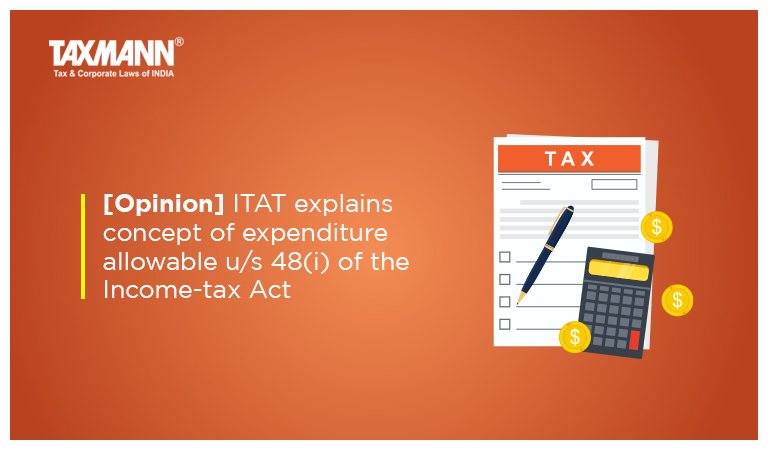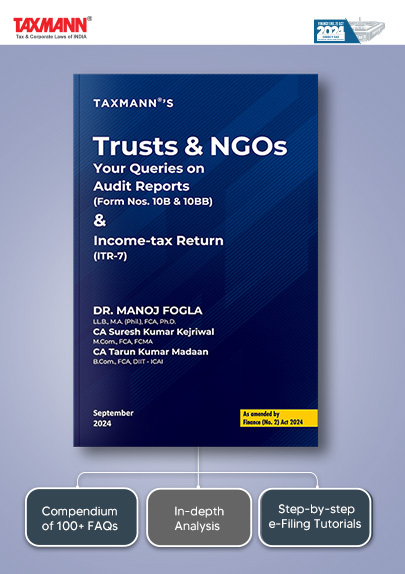[Opinion] ITAT explains concept of expenditure allowable u/s 48(i) of the Income-tax Act
- News|Blog|Income Tax|
- 4 Min Read
- By Taxmann
- |
- Last Updated on 17 September, 2022
S. Krishnan – [2022] 142 taxmann.com 220 (Article)
1. Introduction
The professionals every now and then get an opportunity to learn concepts which are imbedded in the Income-tax Act (the Act) when the judicial authorities through lucid and well written order explain such concepts. One such occasion arose when the ITAT Chennai Bench in the case of Dy. CIT v. Jayapal Sanjay [2022] 142 taxmann.com 120 speaking through Learned Accountant Member explained the concept of encumbrance while allowing the appeal of the Revenue wherein the Tribunal agreeing with the contention of the Revenue disallowed, among other things, amount paid to clear off encumbrance which was self-created by the assessee. It is submitted, with respect, that this is one of the landmark orders passed by the ITAT Chennai Bench and this order can be kept as reference by the assessee’s representatives and Income-tax Department for future guidance in respect of claiming expenditure under section 48(i) of the Act.
Before analysing this order passed by the Tribunal let reference be made to section 48(i) of the Act as well as the meaning of the term “encumbrance”.
2. Section 48(i) of the Act
Section 48 was substituted with effect from 1st April,1988 by section 15 of the Finance Act, 1987 which after substitution -so far as relevant for our discussion- read as under—
48. (1) The income chargeable under the head “Capital gains” shall be computed, —
(a) by deducting from the full value of the consideration received or accruing as a result of the transfer of the capital asset the following amounts, namely: —
(i) expenditure incurred wholly and exclusively in connection with such transfer;
In the section, as it appears as on date, (1) has been removed and only clauses such as (i) (ii) and (iii) appear.
The booklet How to compute capital gains brought out by the Income-tax Department explains “cost of transfer” as under:
“Cost of Transfer
This may include brokerage paid for arranging the deal, legal expenses incurred for preparing conveyance and other documents, cost of inserting advertisements in newspapers for sale of the asset and commission paid to auctioneer, etc. However, it is necessary that the expenditure should have been incurred wholly and exclusively in connection with the transfer. An expenditure incurred primarily for some other purpose but which has helped in effecting the transfer does not qualify for deduction.
Besides an expenditure which is eligible for deduction in computing income under any other head of income, cannot be claimed as deduction in computing capital gains. For example, salary of an employee of a business cannot be deducted in computing capital gains though the employee may have helped in facilitating transfer of the capital asset.
It may be mentioned here that no deduction on account of payment of securities transaction tax on purchase/sale of securities is allowable.”
A few decisions explaining the provisions of clause (i) of section 48 of the Act are set out below.
2.1 The expression “expenditure” used in clause (i) in section 48 should be given the same meaning as used in section 37 of the Act, except that expenditure may be also capital in nature. Expenditure would primarily connote and has the meaning of spending or paying out. In a given case, it may also cover the amount of loss, which has gone out of the assessee’s pocket. Settlement of a claim and payment made can amount to expenditure. Again, the words “wholly and exclusively” used in section 48 are also to be found in section 37 of the Act and relate to the nature and character of the expenditure, which in the case of section 48 must have connection i.e., proximate and perceptible nexus and link with the transfer resulting in income by way of capital gain.
Kaushalya Devi v. CIT [2018] 92 taxmann.com 335/255 Taxman 417/404 ITR 136 (Delhi)
2.2 The provision contained in section 48 shows that the words “wholly and exclusively” do not connote “necessarily”. If the expenses have been incurred in connection with the transfer, they are to be allowed. The words “in connection with” are of wide import and if such expenses have an intimate connection with the transfer, they have to be allowed under section.
Honda Motor Co. Ltd., In re [2018] 90 taxmann.com 180/253 Taxman 402/401 ITR 382/301 CTR 159 (AAR – New Delhi)
2.3 The words ‘in connection with such transfer’ mean intrinsically related to the transfer.
V.A. Vasumathi v. CIT [1980] 126 ITR 94 (Ker.)
2.4 So far as clause (i) of section 48 is concerned, the expression used by the Legislature in its wisdom is wider than the expression ‘for the transfer’. The expression ‘in connection with such transfer’ is certainly wider than the expression ‘for the transfer’. Here again, any amount the payment of which is absolutely necessary to effect the transfer will be an expenditure covered by this clause. In other words, if without removing any encumbrance, sale or transfer could not be effected, the amount paid for removing that encumbrance will fall under clause (i).
CIT v. Smt. Shakuntala Kantilal [1991] 58 Taxman 106/190 ITR 56 (Bom.)
2.5 The expression ‘in connection with such transfer’ is wider than the expression ‘for the transfer’.
Gopee Nath Paul & Sons v. Dy. CIT [2005] 147 Taxman 629/278 ITR 240/198 CTR 116 (Cal.)
Click Here To Read The Full Article
Disclaimer: The content/information published on the website is only for general information of the user and shall not be construed as legal advice. While the Taxmann has exercised reasonable efforts to ensure the veracity of information/content published, Taxmann shall be under no liability in any manner whatsoever for incorrect information, if any.

Taxmann Publications has a dedicated in-house Research & Editorial Team. This team consists of a team of Chartered Accountants, Company Secretaries, and Lawyers. This team works under the guidance and supervision of editor-in-chief Mr Rakesh Bhargava.
The Research and Editorial Team is responsible for developing reliable and accurate content for the readers. The team follows the six-sigma approach to achieve the benchmark of zero error in its publications and research platforms. The team ensures that the following publication guidelines are thoroughly followed while developing the content:
- The statutory material is obtained only from the authorized and reliable sources
- All the latest developments in the judicial and legislative fields are covered
- Prepare the analytical write-ups on current, controversial, and important issues to help the readers to understand the concept and its implications
- Every content published by Taxmann is complete, accurate and lucid
- All evidence-based statements are supported with proper reference to Section, Circular No., Notification No. or citations
- The golden rules of grammar, style and consistency are thoroughly followed
- Font and size that’s easy to read and remain consistent across all imprint and digital publications are applied






 CA | CS | CMA
CA | CS | CMA


